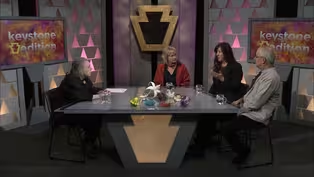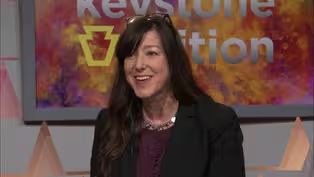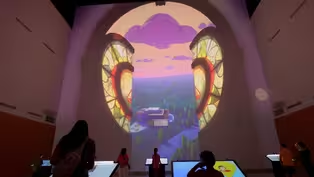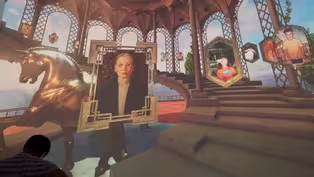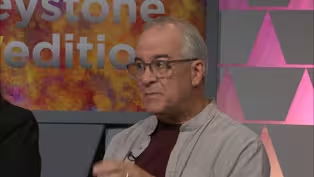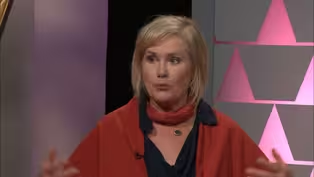Keystone Edition
Modern Renaissance Minds
10/28/2024 | 26m 59sVideo has Closed Captions
Delve into what can be created when seemingly opposite interests like science and art are combined.
Leonardo da Vinci remains a well-known Renaissance artist, engineer, and scientist, and that striking combination lives on in regional artists and students today. Keystone Edition Arts will delve into what can be created when seemingly opposite interests like science and art are combined.
Problems playing video? | Closed Captioning Feedback
Problems playing video? | Closed Captioning Feedback
Keystone Edition is a local public television program presented by WVIA
Keystone Edition
Modern Renaissance Minds
10/28/2024 | 26m 59sVideo has Closed Captions
Leonardo da Vinci remains a well-known Renaissance artist, engineer, and scientist, and that striking combination lives on in regional artists and students today. Keystone Edition Arts will delve into what can be created when seemingly opposite interests like science and art are combined.
Problems playing video? | Closed Captioning Feedback
How to Watch Keystone Edition
Keystone Edition is available to stream on pbs.org and the free PBS App, available on iPhone, Apple TV, Android TV, Android smartphones, Amazon Fire TV, Amazon Fire Tablet, Roku, Samsung Smart TV, and Vizio.
Providing Support for PBS.org
Learn Moreabout PBS online sponsorship- [Presenter] Live from your public media studios, WVIA presents "Keystone Edition Arts," a public affairs program that goes beyond the headlines to address issues in Northeastern and Central Pennsylvania.
This is "Keystone Edition Arts."
And now, Erika Funke.
- Welcome to "Keystone Edition Arts," where we hope to stir your curiosity.
Here's how.
(logo swooshes) - [Sarah] Leonardo da Vinci, the subject of a Ken Burns documentary premiering in November, is a prime example of a Renaissance man.
His curiosity and skills led him to excel in various fields, from art and math to music and science.
He's known for painting the Mona Lisa, studying birds and their flight, and designing ways for humans to be airborne.
He sculpted one of his designs, the horse in clay, with the intention of casting the largest horse ever made in bronze.
Although this dream was not realized in da Vinci's lifetime, it became a passion project of Allentown native and Da Vinci fan, Charles C. Dent.
The result was a 24-foot bronze sculpture presented as a gift to the people of Italy in 1999.
A replica of this sculpture can be seen at the Da Vinci Science Center in Allentown.
Executive director and CEO Lin Erickson describes the center as dedicated to inspiring young people to be curious like Leonardo.
Visitors can actively engage with the artist's legacy in Curiosity Hall by creating a flying machine and self-portrait, fostering participation and learning.
Another organization exploring the connection between science, nature, and art is the Hazelton Integration Project.
In their summer program, students learned about da Vinci and created art in response.
They shared their work with their families and the community in September in an exhibition that showcased the student's creativity and allowed them to share their newfound knowledge and appreciation for da Vinci's work.
For "Keystone Edition Arts," I'm Sarah Scinto, WVIA News.
- We've just heard about Curiosity Hall at the Da Vinci Science Center in Allentown.
Maybe we can think of it like the rabbit hole in "Alice in Wonderland," when Alice is simply burning with curiosity and follows the White Rabbit down into his hole, opening young Alice to a whole new set of unimagined possibilities.
We have three guests who surely ignite that sense of curiosity and wonder in their students and everyone they meet in their creative endeavors.
Tannis Kowalchuk is artistic director of the Farm Arts Collective in Damascus, Pennsylvania.
She is a theater artist, flower farmer, and the co-owner of Willow Wisp Organic Farm.
Her current projects include Dream on the Farm, an annual site-specific performance about climate change created collaboratively with the Farm Arts collective ensemble of performers, farmers, musicians, and community members.
And Alice in ScienceLand, a touring STEAM performance for children ages 5 through 12 focusing on earth science and climate change.
Darlene Farris-LaBar is an associate professor of art at East Stroudsburg University.
She's received an MFA from the School of Art and Design at SUNY, Purchase, a BFA at Indiana University of Pennsylvania, and an AAS in Digital Media Arts from the College of Technology in New York City, as well as numerous awards and grants.
Her work focuses on preserving various plant species of the natural world through the use of 3D digital design and printing, and it has been shown around the world.
She's recently returned from Brazil and the Amazon.
Rand Whipple is the founder and director of Box of Light digital art studios in Bloomsburg.
Over 40 years, his work as a performer for young audiences has taken him to 11 countries and 4 continents.
He's performed at the Smithsonian institution's Discovery Theater, and his work has been presented on public television.
As director of Box of Light, Rand co-founded the Educational Animation Festival with WVIA Public Media in 2016.
And for over 30 years, he's been a teaching artist in the Pennsylvania Council on the Arts' Art in Education Program, conducting over 75 residencies across the state, in schools, art centers, prisons, and early learning centers.
So glad that you're all with us.
Thank you for coming.
Tannis, before you even created Alice in ScienceLand, you were engaging young people in a time warp and you took them back to meet Leonardo.
What were you exploring even then?
- Well, that was a performance that I made years ago now with NACL Theatre, a company I'd founded in New York City, and we were exploring time travel and we were visiting different explorers.
And Leonardo da Vinci was, like, really the favorite moment in the play, because we created this really interesting bicycle with wings.
And, you know, he tried to fly in the show.
And failed, but (laughs)... - We know there are so many facets to Leonardo like that.
And in his recent biography, Walter Isaacson tells us that Leonardo was a producer of theater and pageants, with all the scenery and costumes and stage machinery, that entailed his helicopter may have been something to lift sets originally.
Does that make sense, Tannis, that the arts and engineering all comes together like that in theater?
- I think so.
I think definitely.
In the theater, I mean the engineering is an important part of building and of designing sets and creating experiences.
And so much of the work that we're doing with Farm Arts Collective is also very, very site-specific and experiential, so.
And, of course, the themes are science-based.
So many of our themes are science-based.
So we are very much connecting and using science in our work to create the work that we are interested in sharing with our community.
- Well, then introduce us to Alice in ScienceLand.
- Sure.
Alice in ScienceLand is a theater performance that we built for young audiences, stemming from the performances of our theater ensemble Dream on the Farm.
We created a piece called The Scientists in 2021, and it was an adult performance, and we decided we wanted to take a lot of the themes of that performance because it explores the microcosmos and the macrocosmos, the small and the large.
So the systems like the hydrosphere and the atmosphere.
And we are also exploring the fungus world and the microbiology in a compost pile.
And so we're taking the Alice in ScienceLand adventure story.
And Alice is a reluctant science student, who falls asleep reading her textbook, she'd rather be at the river, and she is taken by the White Rabbit on an adventure to meet creatures from the microcosmos and the macrocosmos.
And it's really interesting science.
And someone just saw it, we were just performing in Scranton at the BFestival at The Greenhouse Project, and they were like, "You're really not talking down to the children."
And I'm like, "No, 'cause there's real science in this."
So we collaborate with a NASA climate scientist, who vets our information and really our content collaborator on the science, so.
- And so in this way, you travel with that show?
- Yes, we're traveling and performing in the region in New York state, and Pennsylvania, Connecticut.
We're trying to perform as much as we can in our off season.
We're also running a farm as well.
So, (laughs) yeah.
- And you work with teachers then?
You have the NASA scientist, who is wonderful, but she sometimes answers questions?
- Yes, Elaine Matthews is the retired NASA scientist who travels with us.
So after we present the performance, and there's six actors in the show, there's lots of music, there's stilt walking, there's wonderful colors, great ideas.
After the performance, and it's a 35-minute performance, 40-minute performance, then Elaine Matthews comes on, and we say, "This is a real scientist," and ask her some questions.
And we allow for five questions after the show just to focus it a little bit.
- And you're the White Rabbit.
- I am.
(Erika and guests laugh) - Thank you, Tannis.
Welcome, Darlene.
It's wonderful to have you here.
And we've just heard that the art that Tannis makes so often is rooted in her concern and passion for climate change, and you have a sense of that in your work.
How does your work manifest your concern for the climate?
- Absolutely.
My work is about bringing awareness, allowing people to see the vulnerable little species in our world.
And so what I do is I look at flowers and plants and then I try to pick out ones that are very significant, that are very much interconnected.
And hopefully, with that in mind, allowing people to see, heightening their perception of our planet more, I hope that people will stop more and understand what's happening to our planet, our world before it's all gone.
- And you actually use the technology of 3D printing- - I do.
- to do these creations.
- Yeah.
Originally, I do come from a traditional art background.
But to me, using digital design and technology is just another tool.
It's the same brain, you know, that I'm using.
And so it's not just about replicating, but it's about, again, having people understand the naturally engineered features that exist in our plant world.
- [Erika] Interesting phrasing there, "the naturally engineered."
- [Darlene] Yeah.
- We know that Leonardo was wild about, if you pardon the term wild, about observing flowers and the botanical world.
And you, as he does in that accurate way, trying to make sure that you represent the spirit as well as giving us a sense of it.
You have actually a quote from Leonardo on your website.
Tell us.
You can tell us what it is.
- All right.
- [Erika] Do you have it?
- I do.
All right, so, "Principles for the development of a complete mind: study the science of art.
Study the art of science.
Develop your senses, especially learn how to see.
Realize that everything connects to everything else."
- Wow.
And so when you, for example, go to Brazil- - Yes.
- You have been all over our region, England, you go around the world and look at the biosphere there.
And when we see your pieces that come out, they're all connected in some way, right?
- Sure.
A lot of it is about, for me, I do travel, but I do travel within the forms themselves.
So when I digitally design, I feel like I'm virtually traveling around a plant, in and out.
And I leave that moment feeling so much more wiser as a person on this planet.
But also, it's really important to know that, you know, these plants, they do grow in very significant locations.
And each location, I think also there's a vulnerability that is happening all throughout our world.
Yeah.
- And you've just returned from the Amazon.
- Yes.
- You've been to Brazil.
What was your experience there?
Again, Leonardo wild about water and water flow.
- Yes.
Oh, yeah, that's a place where everything is, ultimately interconnected.
And it's, you know, a moment where we need to understand that, you know, the Amazon is starting to, I guess, leave us, you know, as there's more development.
And there's a lot of changes already with the climate because of that.
Where I was, I was at a place that in the 1970s it was devastated.
It was deforested.
You know, the animals were poached.
And a scientist from Brazil came in and stopped what was happening and had the government sign a waiver to allow the Indigenous communities to live there, to pretty much take care of the landscape.
And then now, after over 30 years, you know, it's actually grown and it's amazing and it came back to life.
So it leaves us with some hope, you know, that we could bring the Amazon back.
- Whew, wonderful.
Thank you, Tannis.
And, Rand, how good to have you with us.
- Oh, it's nice to see you.
- We've known you so long and all your wonderful work.
And we know that you have roots in theater, as Tannis does, and Leonardo too, as we heard, right?
How did you make the shift, largely the shift from the stage work you'd been doing to the world of digital media arts?
- I helped found a Bloomsburg Theatre Ensemble.
I was an actor with them.
And then I was interested in creating my own work.
And so I went to do that, and it was very physically based.
And as computers came along, I've always just been fascinated with what's possible in the future kinda technologically and so I started experimenting with that.
And when I show what I did with the computer, I actually had one of those gooseneck projectors and the little slides and then moved to carrying big old Macintosh desktops and the big Bondi Blue computers, and I would set those up on the edge of the stage and click the buttons and it would show the images and run the sounds.
And eventually then I got a grant to study programming and I started to program the lights and the sounds so the actors would just walk backstage and hit a button and we'd go for 20 minutes, an actor would hit it.
And with this, looking for this kind of unified field theory of tech being as responsive and fluid and malleable as a human, which of course didn't, it's not that.
So that's how I got into it.
And as we go and tour these shows using this, we do workshops in animation and how to do video, even little bitty robotics we use every once in a while.
And so that grew the Box of Light digital arts studio.
When I started teaching film and animation, programming, robotics, digital design, it all grew, and that's how I made that shift.
- Wow.
Well, as Tannis with her ears, the rabbit ears, you're not, you don't have rabbit ears, but you are taking young people into places where they may never have been.
And one of the things that is a concern certainly for parents and people who are loving of young people is too much screen time.
Too much screen time.
But you are finding ways to face the reality that screens are here with us, but let's do this in a way that can be creative.
- Right, exactly.
And I struggle with it.
I think kids have too much screen time.
But we've always, at Box of Light, said, "It's like you don't stop eating because Twinkies are bad for you.
What you do is you give the appropriate amount of food, of the most nutritious food possible."
So when those kids came into the Box of Light Studio, we want them to be the creators.
We do not want them to be the consumers only.
And we want to connect them.
So everything they did on our website, and the idea is that, we call it the big world connection where you're going, "Yeah, you don't have to be in New York or Vancouver or Los Angeles.
Anybody with skills and knowledge can create.
And you can find a worldwide audience.
You just need that skills and knowledge.
And you can get that online."
So we wanted to go like, "You belong there.
Doesn't matter if you're in Tamaqua, if you're in Bloomsburg, you belong there, And that's the world.
That is your world.
You're not just a consumer, you are the creator of this."
So yeah, but too much screen time is really bad.
I see that in the kids who've come through the studio too.
- Well, you also have, and I think maybe it's part of your theater background, I think that when we get little glimpses of workshops that you've conducted, Rand, we always get the sense that it's not a young person and a computer screen alone in a corner, you always have this beehive of activity where people are interacting with each other and that's what we want to encourage too.
- Completely.
And Tannis knows that theater is communal and filmmaking is communal.
And once you make a little bitty thing, you can do it by yourself.
But basically you interact with other people, and it is a group creation.
You have to have artists, musical artists, visual artists, directors, actors.
And so it's a wonderful collaborative thing.
And if you went through a Box of Light class, you'd see two different things.
You'd see heads together talking and collaborating, and then you'd see the kid go, "Hey, come look at what I did."
And so the learning, we are hardwired to share what we learn.
I think we suffer alone, but when we learn, we have to connect to others to share it.
And so those, yeah, I think it is strong in that way.
Teachers stop action animation is a great kinesthetic, team-oriented activity that you can use to work on math concepts, language, or those all-important social skills.
(kids cheer) - And you, each in your own way, have work that you're doing that is for the benefit of the immediate community you're part of, but also far reaching.
We get that water image of the ripples.
And the way that you care so much, Tannis, about science has to do with your respect for it, right?
It's not just art.
- Right, I think that in creating art, if you're gonna talk about something scientific as climate change, you have to have the data.
The data's really important.
But data doesn't necessarily change minds or open someone's heart.
- [Rand] Yeah.
- So to have both the data and the artistic expressivity and the connection with our community or with our audiences with that data, wow, it's a powerful tool that, you know, is worthy of, like, continuing, in my opinion.
I think it's the way to go forward.
If we're talking about climate change, it has to be connecting all the dots around us, environmental, artistic, scientific, taste, feeling, all of those things.
- It's the myth and the storytelling that changes a mind.
You're right, it's not data.
But it is creating the, "Oh, this is who I am.
This is what the values are.
This is my heroic journey."
It's through the stories that we do that, and that crosses in all, every bit of art you see or hear.
It's all about human stories.
- And, Darlene, you have talked about these exquisite images of, or pieces of sculptor of flowers.
Tell us about these ones that are like little chrysalis figures.
- Oh, yes.
And I do work with scientists as well.
I have a lot of scientist friends.
But yeah, so an example would be this piece here is a sunflower seed.
It's a larger version.
It's just a different perspective of looking at a seed.
Normally, we see the sunflower seed as just the casing, the outer shell.
But here you see the embryo, and as well for the corn seed as well.
And the corn seed has the embryo.
There are forms that we don't typically find when we look at a seed.
So it changes perspectives.
It brings, again, an understanding that there's a life within that little capsule from our plants.
So yeah.
- And you, Tannis, certainly as a farmer, as someone who grows flowers 'cause you have beautiful flowers that you grow as well as vegetables, that must speak to- - Yes.
- Yeah, right?
- I mean, seeds are incredible.
And the different sizes of seeds and the textures of seeds, that's an entirely incredible, like, study in itself.
And, like, how hard it is to plant certain seeds and the time it takes for, anyway, I won't go on, but.
(panelists laugh) I could.
- There's a lot- (voices overlap) - And animation uses 3D printing now a lot.
And like a studio out in Portland, really has done an amazing job.
And I did a residency in Watsontown, in a high school there, and Warrior Run High School, and I emailed Leika and said, "You know, I'm at this school, we're in the middle of the corn fields.
The last day of school, the seniors drive their tractors.
We're creating an animation studio in 60 days.
Would you meet with the students," and they did.
And so we met with the person who did the 3D printing.
And partly all stop-motion, and science, and everything else is about problem solving.
And so I was saying, you know, "We got into this.
We're learning as fast as we can."
And he said, "That's our process as well."
And the technology that we went into Coraline, the first show we did it, or the film we did it with, and we said, "Oh, we need four printers and four computers."
And then they realized, "Oh my God, we need, like, multiple times that."
And so there's the problem solving in all the things that art is, there is this cross-pollination of technology that drives film, and all the other arts.
- Yeah, I think that, to me, technology is like an arm of nature, right?
Because nature has its own technology.
And of course, you know, we utilize technology as tools ourselves.
So I think that's something, just is very important to understand.
And the problem solving is also a very important thing to think about.
You know, how can we use technology in a good way for our planet?
Because 3D printing, for example, is a tool that we use in so many places and venues and different situations around the world.
You know, whether it's medical or whether it's, you know, a product or something that will take us to outer space.
So, again, it's, you know, trying to solve maybe some problems that could help the planet with the technology, the tools, the creative brains, you know, science, everything altogether, which again is also a Leonardo da Vinci kind of thought.
- But, you know, what's interesting, and I'm gonna monopolize this.
When I teach kids, there's process and then there's what is being expressed.
And the kids get the process (fingers snap) like that.
They come in knowing the process, and, "Oh, here's how I do it."
And those who cannot engage in storytelling are bored out of their minds.
For stop-motion animation anyway, 'cause that requires a lot of repetitive actions.
But, you know, if you have that storytelling motor, then you can create.
And once you just aren't interested in the process, then that peels off very quickly.
- And, Tannis, you are process-driven in the way you create theater, don't you?
You are a playwright and you write plays and scripts and bring things together.
But this comes out of the stories that people you're working with tell you.
- Yes, we have a theme of climate change in our work.
But the company, the collective, as we are called, Farm Arts Collective, brings their stories and their points of view to the process.
So it's multifaceted, and don't really know where we're gonna go when we start.
- And that sounds like creativity of plenty.
Well, we certainly have places of wonder to explore.
Curiosity Hall at the Da Vinci Science Center in Allentown, the Farm Arts Collective's agricultural center on Willow Wisp Organic Farm, the Box of Light in Bloomsburg.
And we can travel with you, Darlene Farris-LaBar along the Amazon.
Thanks for piquing our curiosity, as you've all just done.
We'd like to thank our guests, Tannis, Darlene, Rand, and you for watching.
For more information on this topic, including links to our guests and resources, please visit wvia.org/keystone and click on Keystone Edition Arts.
And remember, you can watch this episode or any previous episode on demand anytime online or on the WVIA app.
For "Keystone Edition," I'm Erika Funke.
Thank you for watching.
(lively guitar music) ♪ Somethin' good is gonna happen ♪ ♪ Somethin' good is gonna happen ♪ ♪ Somethin' good is gonna happen ♪ ♪ Is gonna happen any day ♪ ♪ Somethin' good is gonna happen ♪ ♪ Somethin' beautiful is happening at my window ♪ ♪ I just have to open up and let it in ♪ ♪ Somethin' good is gonna happen ♪ ♪ Somethin' good is gonna happen ♪ ♪ Somethin' beautiful ♪ ♪ Is gonna happen any day ♪ (audience applauding) - [Audience Member] Bravo!
(audience cheering)
Blending Science, Nature and Art
Clip: 10/28/2024 | 6m 53s | A discussion with Tannis Kowalchuk, Darlene Farris-LaBar, and Rand Whipple (6m 53s)
Modern Renaissance Minds - Preview
Preview: 10/28/2024 | 30s | Watch Monday, October 28th at 7pm on WVIA TV (30s)
Overview - Modern Renaissance Minds
Clip: 10/28/2024 | 1m 34s | We examine organizations and people carrying on the renaissance spirit of Leonardo DaVinci (1m 34s)
Clip: 10/28/2024 | 5m 5s | Rand Whipple - Founder & Director of Box of Light Digital Art Studios (5m 5s)
Clip: 10/28/2024 | 4m 22s | Tannis Kowalchuk - Artistic Director, Farm Arts Collective (4m 22s)
Providing Support for PBS.org
Learn Moreabout PBS online sponsorship
- News and Public Affairs

Top journalists deliver compelling original analysis of the hour's headlines.

- News and Public Affairs

FRONTLINE is investigative journalism that questions, explains and changes our world.












Support for PBS provided by:
Keystone Edition is a local public television program presented by WVIA
